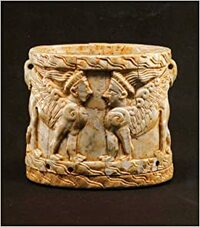Take a photo of a barcode or cover
2 reviews for:
Cultures in Contact: From Mesopotamia to the Mediterranean in the Second Millennium B.C.
Yelena Rakic, Sarah Graff, Joan Aruz
2 reviews for:
Cultures in Contact: From Mesopotamia to the Mediterranean in the Second Millennium B.C.
Yelena Rakic, Sarah Graff, Joan Aruz
This book contains some interesting, specialized contributions on the mutual contacts within the space of the ancient Near East in the 2nd millennium BCE. It was a period when only in the Nile Valley there was a more or less homogeneous civilization with a remarkable artistic output (the Middle Kingdom and the New Kingdom). In the Mesopotamian space the time of the great Akkadian kingdom was over and we see a succession of semi-nomadic peoples (Amorrites, Hurrians, Kassites, Mitanni...) who succeeded each other in rapid succession but nevertheless managed to maintain a fairly large cultural continuity (especially thanks to cuneiform script). In the margins of this you have some remarkable cultures in Anatolia (Hittites), the Syrian-Levantine space and the Aegean area (Crete, Mycenae). All these areas were in contact with each other to a greater or lesser extent, not only through trade, but in some periods even intensely diplomatically.
This book highlights some aspects of this interaction. For me, the most interesting contributions were: on the intense exchange between Egypt and the Aegean area (the shipwreck of Uluburun, 13th century, is the most striking expression of this), on elephant hunting in Western Syria (!), and on the enormously rich production of ivory works of art (the technique would even be lost after 1200 BCE).
Most remarkable for me was the article about the 'solarization' of kingship in Syria, Anatolia and Assyria, in the second half of the 2nd millennium. Anyone who thought that Akhnaton was a unique Egyptian phenomenon will have to reconsider: apparently, in many other regions there was a tendency to see the sun as the supreme divine phenomenon and to connect it with kingship. As Beate Pongratz-Leisten writes: “in two distinct moments of political expansion and concurrent domestic stability, both the Hittites and the Assyrians, interconnect through the culture of the late Hittite kingdoms, chose a common pictorial program to express an understanding of human and divine kingship that drew upon similar variables, yet differed significantly in its message.” It turned out to be only a temporary phenomenon (until about 1200 BCE), but it was revived under Ashurbanipal in the 7th century BCE.
This book also rightly underlines how fragmentary the source material is for this period, and therefore how careful we must be in statements and conclusions. A warning that is far too often discarded, even by specialists.
This book highlights some aspects of this interaction. For me, the most interesting contributions were: on the intense exchange between Egypt and the Aegean area (the shipwreck of Uluburun, 13th century, is the most striking expression of this), on elephant hunting in Western Syria (!), and on the enormously rich production of ivory works of art (the technique would even be lost after 1200 BCE).
Most remarkable for me was the article about the 'solarization' of kingship in Syria, Anatolia and Assyria, in the second half of the 2nd millennium. Anyone who thought that Akhnaton was a unique Egyptian phenomenon will have to reconsider: apparently, in many other regions there was a tendency to see the sun as the supreme divine phenomenon and to connect it with kingship. As Beate Pongratz-Leisten writes: “in two distinct moments of political expansion and concurrent domestic stability, both the Hittites and the Assyrians, interconnect through the culture of the late Hittite kingdoms, chose a common pictorial program to express an understanding of human and divine kingship that drew upon similar variables, yet differed significantly in its message.” It turned out to be only a temporary phenomenon (until about 1200 BCE), but it was revived under Ashurbanipal in the 7th century BCE.
This book also rightly underlines how fragmentary the source material is for this period, and therefore how careful we must be in statements and conclusions. A warning that is far too often discarded, even by specialists.
These are the texts of a symposium accompanying an exhibition 'Beyond Babylon' held at the MET, the Metropolitan Museum of Arts in NY, in 2008 and 2009. The book covers various aspects of regional contacts in the ancient Near East, in the 2nd millennium BCE , a period that – apart from the Egyptian Nile Valley – was much less homogeneous than the preceding or following millennia (and for which we actually have far fewer sources). Notably absent: the Hebrews; the introduction itself points this out as remarkable but at the same time also justified, because in this period (the 2nd millennium) this people (if we can speak of a real people) was still really on the margins of history. I explore some other aspects in my review in my History account on Goodreads: https://www.goodreads.com/review/show/5999182753.
The text of this book is a free download on the site of the MET.
The text of this book is a free download on the site of the MET.
